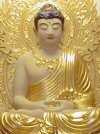Table C. Pronunciation of the 33 Consonants
|
| 1. Velar or guttural sounds are produced by touching the rear of the tongue to the soft palate near the throat. |
| k |
kāya (body), like skill or skin |
| kh |
sukha (happiness), like kill or kin |
| g |
gagana (sky), like gazelle orgo |
| gh |
gharma (heat), like doghouse |
| ṅ |
gaṅgā (the Ganges), like mingle or hunger |
| 2. Palatal sounds are produced by touching the blade of the tongue to the front palate. |
| c |
cakra (wheel), like chuck or choke, but without aspiration |
| ch |
chāya (shadow), like chuck or choke |
| j |
jaya (victory), like jug or joke. |
| jh |
nirjhara (waterfall), like j-hug or fudge-home |
| ñ |
jñāna (wisdom), like canyon. Some people change the sound of j and pronounce this word like gnyāna, or like dnyāna. |
| 3. Cerebral sounds are produced by retroflexing the tongue to touch the hard palate. |
| ṭ |
koṭi (ten million, the edge), like star or stow, with the tongue retroflexed |
| ṭh |
adhiṣṭhāna (rule over), like tar or tow, with the tongue retroflexed |
| ḍ |
vaiḍūrya (aquamarine), like douse or dead, with the tongue retroflexed |
| ḍh |
mūḍha (perplexed), like madhouse or redhead, with the tongue retroflexed |
| ṇ |
maṇi (jewel), like nativity or note, with the tongue retroflexed |
| 4. Dental sounds are produced by touching the tip of the tongue to the back of the front teeth near their roots. |
| t |
tad (he, she, or it), like star or stow |
| th |
tathāgata (the thus-come One), like tar or tow |
| d |
dāna (the act of giving), like douse or dead |
| dh |
dhāraṇī (retention), like madhouse or redhead |
| n |
nāga (dragon), like nativity or note |
| 5. Labial sounds are produced by closing and opening the lips. |
| p |
padma (red lotus), like spin or spoke |
| ph |
phala (fruit), like pin or poke |
| b |
bodhi (enlightenment), like bore or bout |
| bh |
bhagavān (the world-honored one), like abhore or hobhouse |
| m |
mudrā (seal), like magenta or mode |
| 6. Four semi-vowels, the sounds of which are formed by slight contact. |
| y |
hṛdaya (heart, mind), like yeast or yoga |
| r |
ratna (jewel), like rite or rote, with the tongue slighly tapping the front palate. Avoid bunching the lips for the implicit w or u before the r-syllable as in English, which causes rite to be pronounced as write, and rote as wrote. |
| l |
loka (world), like lagoon or lotus |
| v |
If not preceded by a consonant, it is pronounced as v; e.g., avidyā (ignorance). If preceded by a constant, it may be pronounced as w. Thus, sattva (being, creature) may be pronounced as sa-ttwa, sarva (all) as sar-wa, adhvan (time) as a-dhwan, and svāhā (hail) as swā-hā. |
| 7. Four sibilants, the sounds of which are formed by half contact |
| ś |
śuddha (pure), like ship or show |
| ṣ |
uṣṇīṣa (crown of the head), like ship or show, with the tongue retroflexed |
| s |
sama (equal), like salute or solo |
| h |
hasta (hand), like habituate or holy |
| 8. Other sounds: |
Anusvāra
(ṁ) |
The preceding verb is nasalized; e.g., saṁskāra (formation, mental processing) is pronounced as sangskāra, and hūṁ (a mantra syllable) as hūng. |
Visarga
(ḥ) |
The preceding verb is faintly echoed; e.g., namaḥ (homage) is pronounced as namaha, narayoḥ (of the two men) as narayoho, naraiḥ (with the men) as naraihi, and duḥkha (sorrow) as duhukha. |









